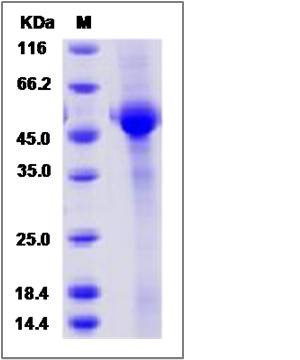Rat CD8A / Lyt2 Protein (Fc Tag)
CD8A
- 100ug (NPP1019) Please inquiry
| Catalog Number | P80285-R02H |
|---|---|
| Organism Species | Rat |
| Host | Human Cells |
| Synonyms | CD8A |
| Molecular Weight | The recombinant rat CD8A/Fc is a disulfide-linked homodimer. The reduced monomer comprises 404 amino acids and has a predicted molecular mass of 45 kDa. The apparent molecular mass of the protein is approximately 46 kDa in SDS-PAGE under reducing conditions due to glycosylation. |
| predicted N | Gln 27 |
| SDS-PAGE |  |
| Purity | > 90 % as determined by SDS-PAGE |
| Protein Construction | A DNA sequence encoding the rat CD8A (P07725) (Met1-Tyr189) was expressed with the Fc region of human IgG1 at the C-terminus. |
| Bio-activity | |
| Research Area | Immunology |Signal Transduction |Metabolism |Types of disease |Metabolism in Cancer |
| Formulation | Lyophilized from sterile PBS, pH 7.4. 1. Normally 5 % - 8 % trehalose and mannitol are added as protectants before lyophilization. Specific concentrations are included in the hardcopy of COA. |
| Background | Human T-cell surface glycoprotein CD8 alpha chain, also known as CD8a, is a single-pass type I membrane protein. The CD8 glycoprotein is expressed by thymocytes, mature T cells and natural killer (NK) cells and has been implicated in the recognition of monomorphic determinants on major histocompatibility complex (MHC) Class I antigens, and in signal transduction during the course of T-cell activation. Both human and rodent CD8 antigens are comprised of two distinct polypeptide chains, alpha and beta. The Ig domains of CD8 alpha are involved in controlling the ability of CD8 to be expressed. Mutation of B- and F-strand cysteine residues in CD8 alpha reduced the ability of the protein to fold properly and, therefore, to be expressed. Defects in CD8A are a cause of familial CD8 deficiency. Familial CD8 deficiency is a novel autosomal recessive immunologic defect characterized by absence of CD8+ cells, leading to recurrent bacterial infections. |
| Reference | References Devine, L. et al., 2000, J Immunol. 164 (2): 833-8. Arcaro, A. et al., 2000, J Immunol. 165 (4): 2068-76. Saha, K. et al., 2001, Nat Med. 7 (1): 65-72. Romero, P. et al., 2005, Eur J Immunol. 35 (11): 3092-4. |
